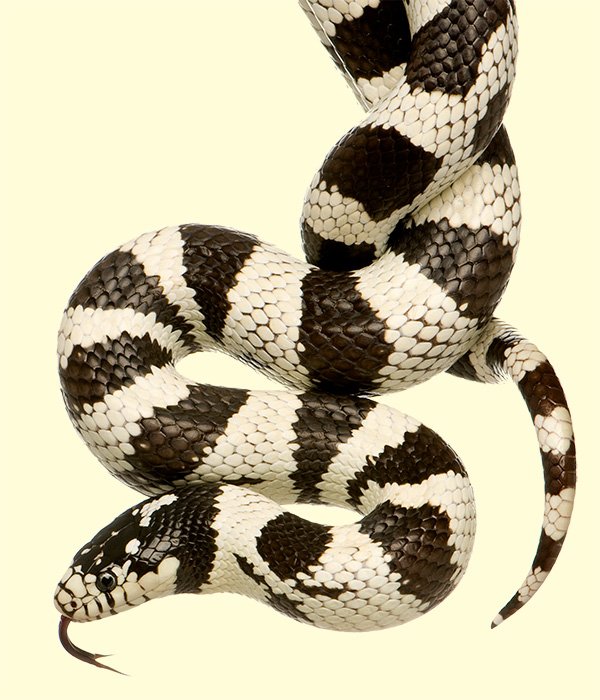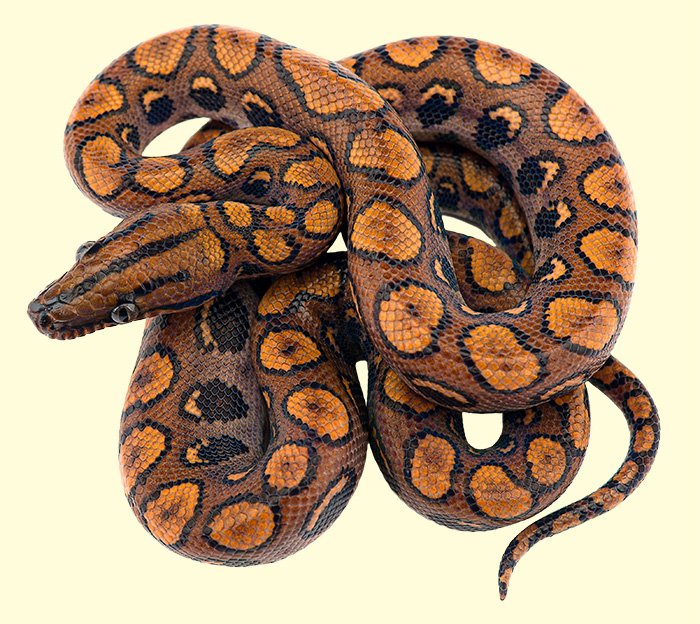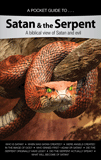
Satan’s Serpents or the Creator’s Creatures?
A biblical perspective separates truth from myth about snakes.
When I adopted my ball python, Persephone, a few family members asked if something was wrong with me. I heard warnings from others that she would “size me up for dinner.” But her head is the size of a walnut, she’s scared of grass, and she moves at a blinding speed of one mile per hour. She’s a far cry from a “man-eater.” However, those sentiments resemble the maligning accusations I’ve heard from many guests during my years of presenting snakes at the Ark Encounter and Creation Museum zoos. My heart aches when I hear such vitriol about these unique and beautiful animals.
This general aversion to snakes turns more insidious among some Christians who claim that snakes are evil, demonic, or satanic. These beliefs likely stem from the Genesis account of Satan taking the form of a serpent to tempt Eve in the garden of Eden (Genesis 3:1–7), ultimately leading to God cursing creation (Genesis 3:14–19). This interpretation of Scripture, combined with unfounded folklore and exaggerated portrayals of snakes in movies and other media, contributes to the fear of snakes being the second most common animal phobia, only behind the fear of spiders.1 But we can easily debunk the myths perpetuating this fear by examining snakes through a biblical lens.
Myth 1
The Bible says that snakes are evil
Snakes were created by God on day six of creation week (Genesis 1:25). But they were not made in the image of God like humans (Genesis 1:26–27). Snakes are just animals, subject to their God-given designs and instincts. They are incapable of good or evil because they are not moral beings like humans.
When God first created snakes, they were vegetarian, because the world was very good (Genesis 1:29–31). Only after Adam and Eve sinned was creation cursed, and animals began killing each other. Humans, not snakes, broke God’s very good creation.
For those who have received his offer of salvation through Jesus’ death on the cross (John 3:16), God promises a future where “the nursing child shall play over the hole of the cobra, and the weaned child shall put his hand on the adder’s den” (Isaiah 11:8). If snakes were evil, God would not include them in his restored perfect creation.
Myth 2
Snakes are the embodiment of Satan and vessels for demons
This misconception likely stems from the serpent’s role in the Genesis account of the fall and from the comparison of Satan to a serpent elsewhere in Scripture (Revelation 12:9, 20:2). However, Satan is also compared to a roaring lion (Joel 1:6; Amos 3:8; 1 Peter 5:8), but rarely does anyone accuse lions of being the embodiment of Satan.
Snakes are not the only creatures associated with Satan or demons in Scripture. Pigs were taken over by demons in Mark 5:1–16, but people typically don’t consider pigs evil. And as the serpent was used as a vessel by Satan in Genesis, so was Judas Iscariot (John 13:27). Hosts of other people were taken captive by demons that Christ, his disciples, and prophets cast out. All these possessions don’t mean snakes, lions, pigs, or humans are more innately evil than other creatures. All animals—not just snakes—were cursed because of mankind’s sin.
Myth 3
Snakes are the offspring of Satan
God’s curse on the serpent says that its offspring would conflict with the woman’s offspring (Genesis 3:14–15). Christ is the offspring of the woman (Galatians 3:16–19). But who was the offspring of the serpent?
In John 8, Jesus addressed those who spoke against him and said they were of their father, the devil. John the Baptist and Jesus both said that the Pharisees, Sadducees, and scribes who opposed Christ were a brood or offspring of vipers or serpents in a spiritual sense (Matthew 3:7, 12:34, 23:33; Luke 3:7). Therefore, the offspring of the devil (who used a serpent as a vessel) are those who oppose Christ, specifically those who crucified him (John 19:6–18). Snakes are just animals and do not oppose Christ. Therefore, they are not the devil’s children.
Myth 4
Snakes are dangerous man-eaters
In the US, you’re nine times more likely to die from a lightning strike than a snake bite.2 While some snakes possess deadly venom in today’s fallen world, only about 5% of the roughly 3,500 snake species can kill humans. And very few snakes ever grow large enough to consider a human as a meal. In fact, dogs kill five times more people than snakes in the US,3 but you rarely hear that “the only good dog is a dead dog.”
While my snake, Persephone, has learned to trust me, the vast majority of snakes see humans as predators and inherently fear us. And when they’re afraid, snakes will defend themselves—not because they’re evil, but because they’re trying to survive. In our fallen world, features such as constriction, defensive behavior, and venom point to a creative Designer.
The Creator’s Crafted Creatures
The fear of snakes is so ingrained in human culture that people are blinded to the facts in favor of their feelings. If my family and friends took a moment to observe Persephone, they’d realize she poses no threat to them. She’s a fascinating pet with her own personality—she enjoys exploring, snuggling in my hoodie, and even watching TV.
Despite the frequent connection between snakes and the occult in entertainment, snakes are God’s creatures, not symbols of evil. Because God created snakes, they belong to him; therefore, humans are charged with their stewardship. Instead of remaining rooted in fear, you can learn about snakes. Appreciate the role they play in nature. Admire their amazing design—even if it’s from behind a window at a zoo. And respect them as one of our Creator’s exquisitely crafted creatures.
Each of the roughly 3,500 snake species around the world is uniquely designed by our Creator. Check out a few of the incredible species I help care for at the Ararat Ridge Zoo!
California Kingsnake

Kingsnakes are the world’s strongest snakes. Their squeeze pressure is stronger than a healthy adult human’s blood pressure. Because they eat other snakes, including much larger species, they must squeeze really hard to overpower them.4
Taiwan Beauty Snake

Taiwan beauty snakes are designed with strong, prehensile tails that allow them to dangle from trees or caves to catch birds or bats in flight. They’re so strong, they can pull their entire long bodies back up just by the tips of their tails.
Brazilian Rainbow Boa

Rainbow boas have extra ridges on their scales that act like tiny prisms, reflecting sunlight as a brilliant rainbow of iridescence along their bodies. They are one of God’s most stunning creatures.
Pueblan Milk Snake

Harmless Pueblan milk snakes mimic the colors of deadly coral snakes to discourage potential predators. While snake venom can be deadly, it’s also saving lives in treatments for cancer, heart disease, neurological disorders, and more.
Answers Magazine
July–September 2023
The undercurrent of Critical Race Theory is tugging students away from God’s Word. How should parents respond?
Browse Issue SubscribeFootnotes
- Jakub Polák, Silvie Rádlová, Markéta Janovcová, Jaroslav Flegr, Eva Landová, and Daniel Frynta, “Scary and nasty beasts: Self-reported fear and disgust of common phobic animals,” British Journal of Psychology, June 11, 2019, https://doi.org/10.1111/bjop.12409.
- Steve A. Johnson, “Frequently Asked Questions About Venomous Snakes,” University of Florida, January 13, 2022, https://ufwildlife.ifas.ufl.edu/venomous_snake_faqs.shtml.
- Jared A. Forrester, Thomas G. Weiser, and Joseph D. Forrester, “An update on fatalities due to venomous and nonvenomous animals in the United States,” Wilderness & Environmental Medicine, January 18, 2018, https://doi.org/10.1016/j.wem.2017.10.004.
- David A. Penning and Brad R. Moon, “The king of snakes: performance and morphology of intraguild predators (Lampropeltis) and their prey (Pantherophis),” The Journal of Experimental Biology, March 15, 2017, https://doi.org/10.1242/jeb.147082.
Recommended Resources

Answers in Genesis is an apologetics ministry, dedicated to helping Christians defend their faith and proclaim the good news of Jesus Christ.
- Customer Service 800.778.3390
- © 2024 Answers in Genesis





